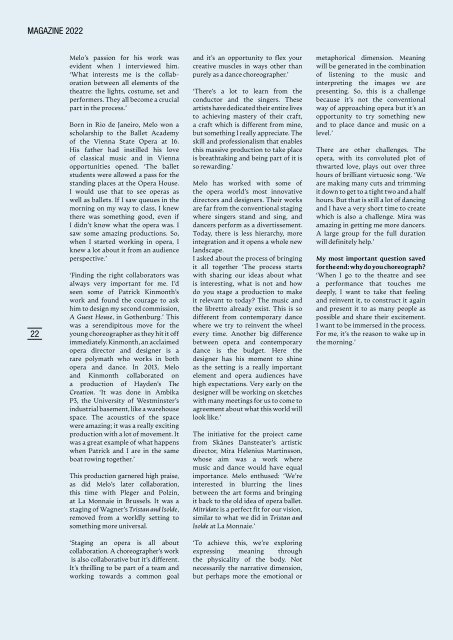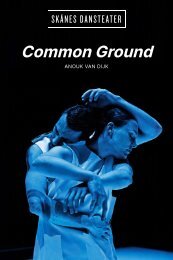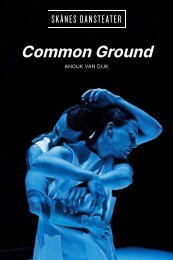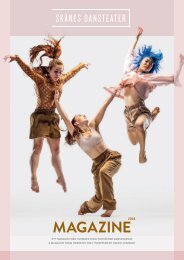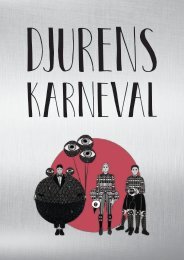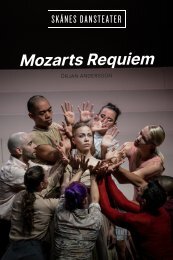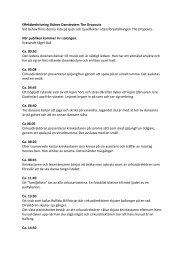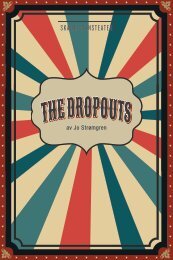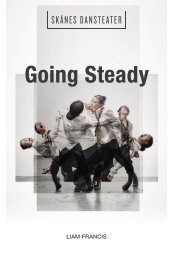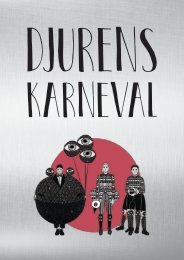Skånes Dansteater Magazine 2022
Skånes Dansteaters magasin om dansen, föreställningarna, mötena och konstnärerna som väntar på Sveriges enda fristående dansinstitution. Skånes Dansteater's Magazine 2022 about the dance, the performances, the artists, the encounters and the artists we are hosting during 2022.
Skånes Dansteaters magasin om dansen, föreställningarna, mötena och konstnärerna som väntar på Sveriges enda fristående dansinstitution.
Skånes Dansteater's Magazine 2022 about the dance, the performances, the artists, the encounters and the artists we are hosting during 2022.
Create successful ePaper yourself
Turn your PDF publications into a flip-book with our unique Google optimized e-Paper software.
MAGAZINE <strong>2022</strong><br />
MITRIDATE<br />
Melo’s passion for his work was<br />
evident when I interviewed him.<br />
‘What interests me is the collaboration<br />
between all elements of the<br />
theatre: the lights, costume, set and<br />
performers. They all become a crucial<br />
part in the process.’<br />
Born in Rio de Janeiro, Melo won a<br />
scholarship to the Ballet Academy<br />
of the Vienna State Opera at 16.<br />
His father had instilled his love<br />
of classical music and in Vienna<br />
opportunities opened. ‘The ballet<br />
students were allowed a pass for the<br />
standing places at the Opera House.<br />
I would use that to see operas as<br />
well as ballets. If I saw queues in the<br />
morning on my way to class, I knew<br />
there was something good, even if<br />
I didn’t know what the opera was. I<br />
saw some amazing productions. So,<br />
when I started working in opera, I<br />
knew a lot about it from an audience<br />
perspective.’<br />
‘Finding the right collaborators was<br />
always very important for me. I’d<br />
seen some of Patrick Kinmonth’s<br />
work and found the courage to ask<br />
him to design my second commission,<br />
A Guest House, in Gothenburg.’ This<br />
was a serendipitous move for the<br />
22 young choreographer as they hit it off every time. Another big difference For me, it’s the reason to wake up in<br />
23<br />
immediately. Kinmonth, an acclaimed<br />
opera director and designer is a<br />
rare polymath who works in both<br />
opera and dance. In 2013, Melo<br />
and Kinmonth collaborated on<br />
a production of Hayden’s The<br />
Creation. ‘It was done in Ambika<br />
P3, the University of Westminster’s<br />
industrial basement, like a warehouse<br />
space. The acoustics of the space<br />
were amazing; it was a really exciting<br />
production with a lot of movement. It<br />
was a great example of what happens<br />
when Patrick and I are in the same<br />
boat rowing together.’<br />
This production garnered high praise,<br />
as did Melo’s later collaboration,<br />
this time with Pleger and Polzin,<br />
at La Monnaie in Brussels. It was a<br />
staging of Wagner’s Tristan and Isolde,<br />
removed from a worldly setting to<br />
something more universal.<br />
‘Staging an opera is all about<br />
collaboration. A choreographer’s work<br />
is also collaborative but it’s different.<br />
It’s thrilling to be part of a team and<br />
working towards a common goal<br />
and it’s an opportunity to flex your<br />
creative muscles in ways other than<br />
purely as a dance choreographer.’<br />
‘There’s a lot to learn from the<br />
conductor and the singers. These<br />
artists have dedicated their entire lives<br />
to achieving mastery of their craft,<br />
a craft which is different from mine,<br />
but something I really appreciate. The<br />
skill and professionalism that enables<br />
this massive production to take place<br />
is breathtaking and being part of it is<br />
so rewarding.’<br />
Melo has worked with some of<br />
the opera world’s most innovative<br />
directors and designers. Their works<br />
are far from the conventional staging<br />
where singers stand and sing, and<br />
dancers perform as a divertissement.<br />
Today, there is less hierarchy, more<br />
integration and it opens a whole new<br />
landscape.<br />
I asked about the process of bringing<br />
it all together ‘The process starts<br />
with sharing our ideas about what<br />
is interesting, what is not and how<br />
do you stage a production to make<br />
it relevant to today? The music and<br />
the libretto already exist. This is so<br />
different from contemporary dance<br />
where we try to reinvent the wheel<br />
between opera and contemporary<br />
dance is the budget. Here the<br />
designer has his moment to shine<br />
as the setting is a really important<br />
element and opera audiences have<br />
high expectations. Very early on the<br />
designer will be working on sketches<br />
with many meetings for us to come to<br />
agreement about what this world will<br />
look like.’<br />
The initiative for the project came<br />
from Skånes <strong>Dansteater</strong>’s artistic<br />
director, Mira Helenius Martinsson,<br />
whose aim was a work where<br />
music and dance would have equal<br />
importance. Melo enthused: ‘We’re<br />
interested in blurring the lines<br />
between the art forms and bringing<br />
it back to the old idea of opera ballet.<br />
Mitridate is a perfect fit for our vision,<br />
similar to what we did in Tristan and<br />
Isolde at La Monnaie.’<br />
‘To achieve this, we’re exploring<br />
expressing meaning through<br />
the physicality of the body. Not<br />
necessarily the narrative dimension,<br />
but perhaps more the emotional or<br />
metaphorical dimension. Meaning<br />
will be generated in the combination<br />
of listening to the music and<br />
interpreting the images we are<br />
presenting. So, this is a challenge<br />
because it’s not the conventional<br />
way of approaching opera but it’s an<br />
opportunity to try something new<br />
and to place dance and music on a<br />
level.’<br />
There are other challenges. The<br />
opera, with its convoluted plot of<br />
thwarted love, plays out over three<br />
hours of brilliant virtuosic song. ‘We<br />
are making many cuts and trimming<br />
it down to get to a tight two and a half<br />
hours. But that is still a lot of dancing<br />
and I have a very short time to create<br />
which is also a challenge. Mira was<br />
amazing in getting me more dancers.<br />
A large group for the full duration<br />
will definitely help.’<br />
My most important question saved<br />
for the end: why do you choreograph?<br />
‘When I go to the theatre and see<br />
a performance that touches me<br />
deeply, I want to take that feeling<br />
and reinvent it, to construct it again<br />
and present it to as many people as<br />
possible and share their excitement.<br />
I want to be immersed in the process.<br />
the morning.’<br />
“This is so different from<br />
contemporary dance where we try<br />
to reinvent the wheel every time.”<br />
SKÅNES DANSTEATER


